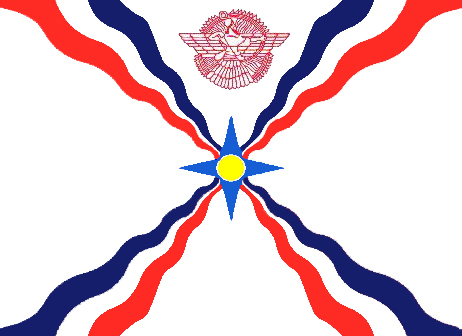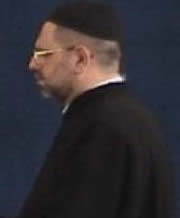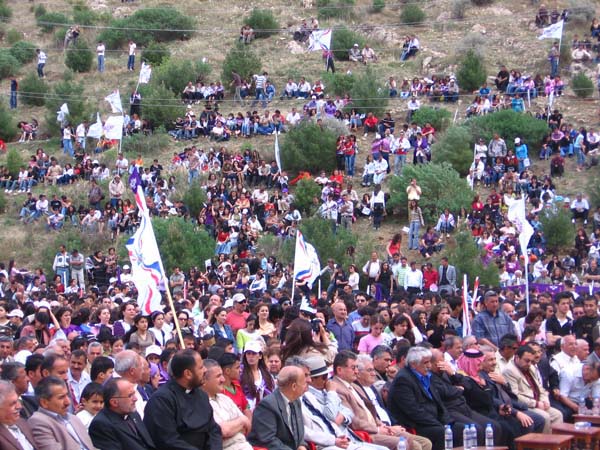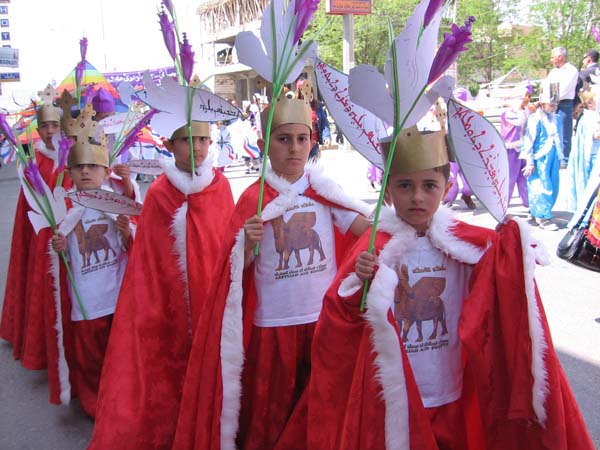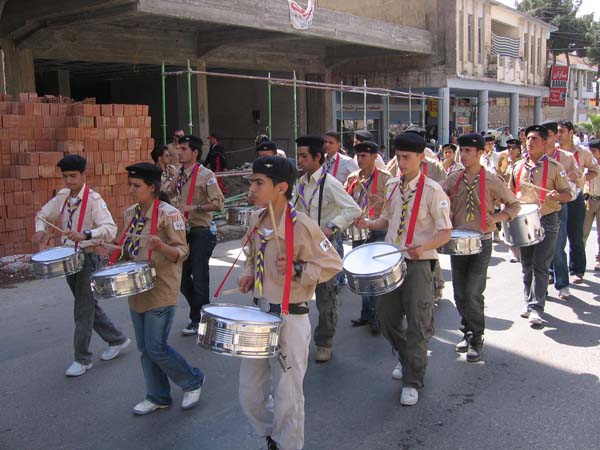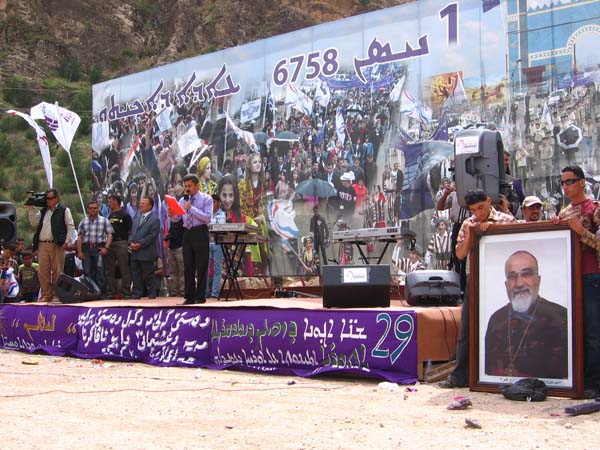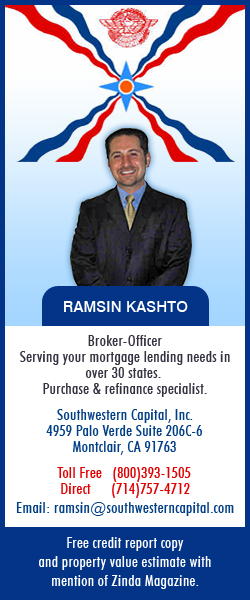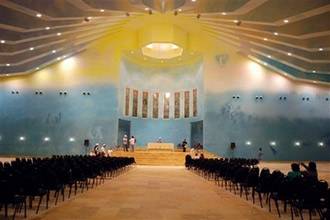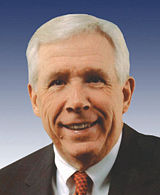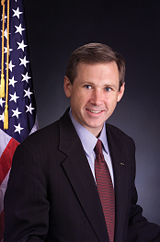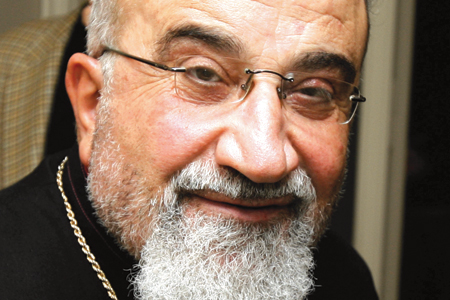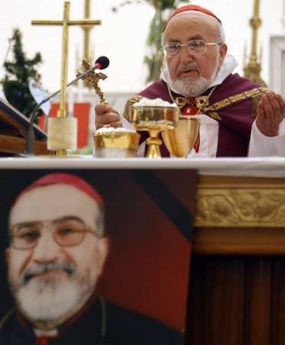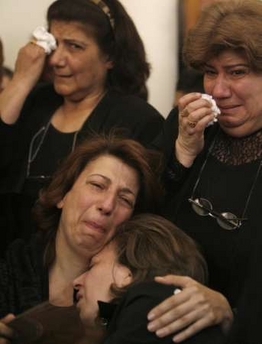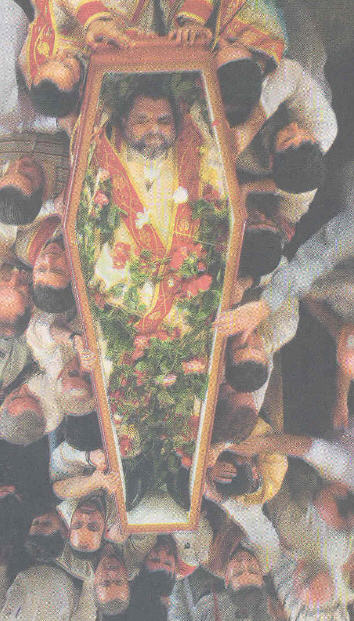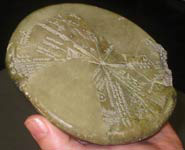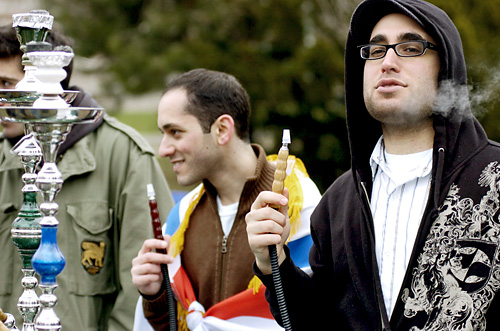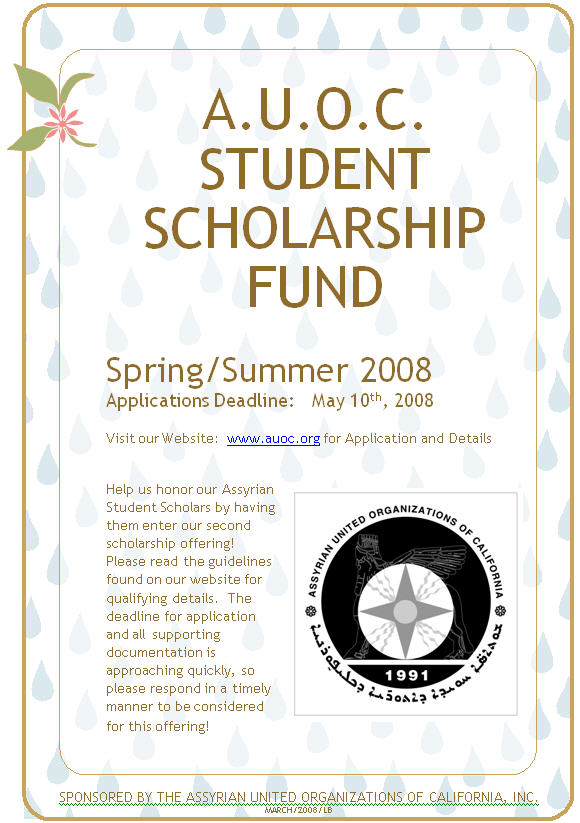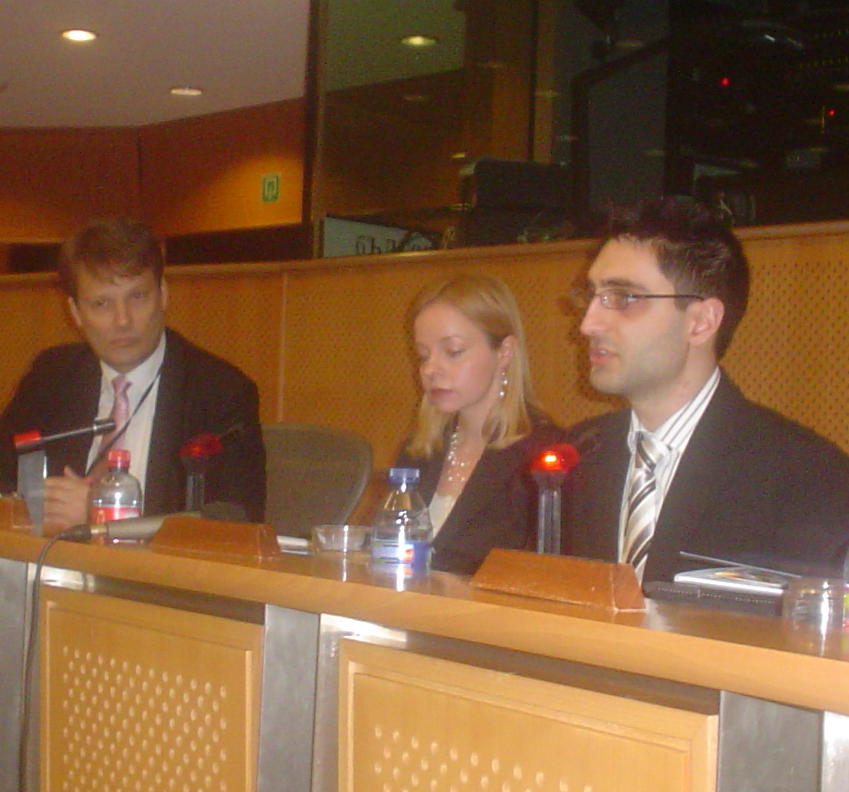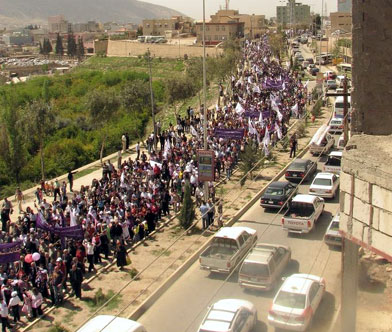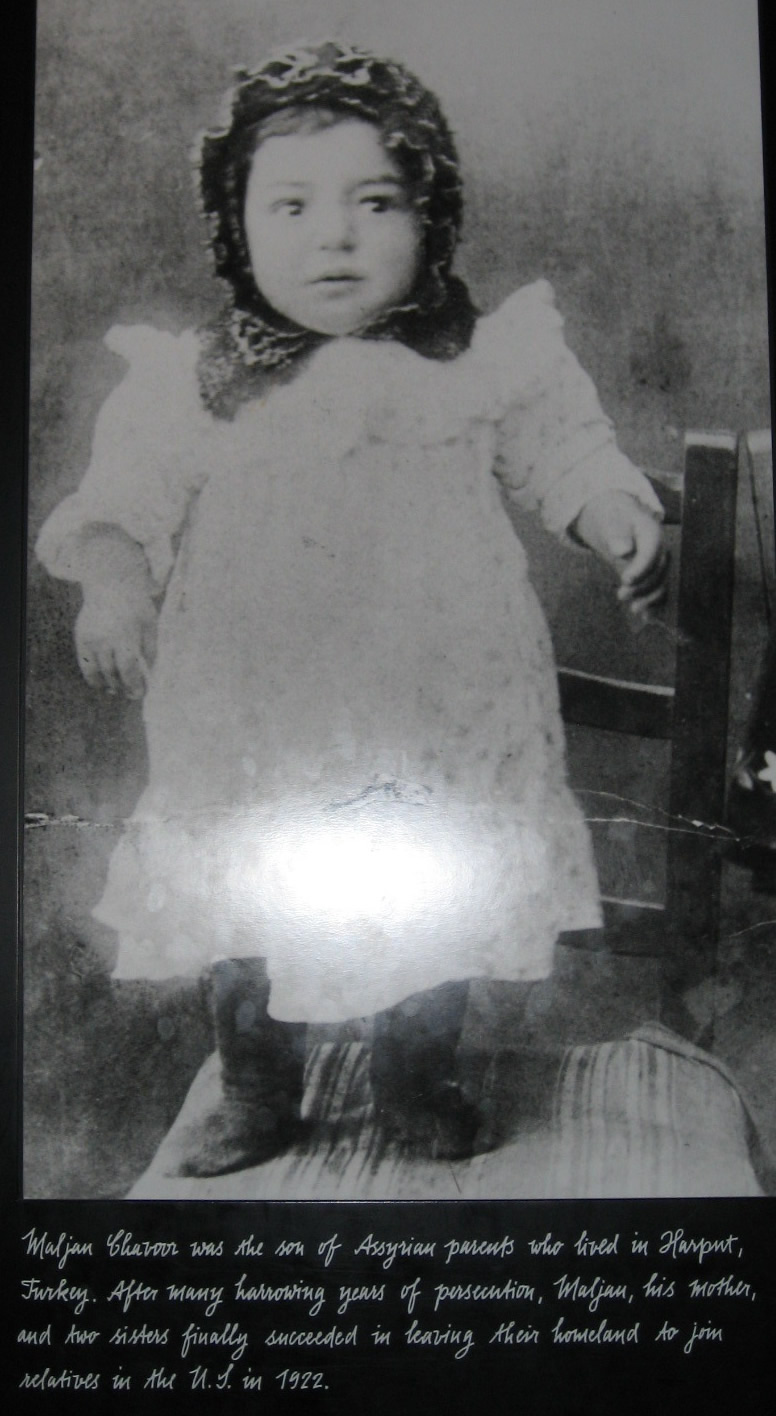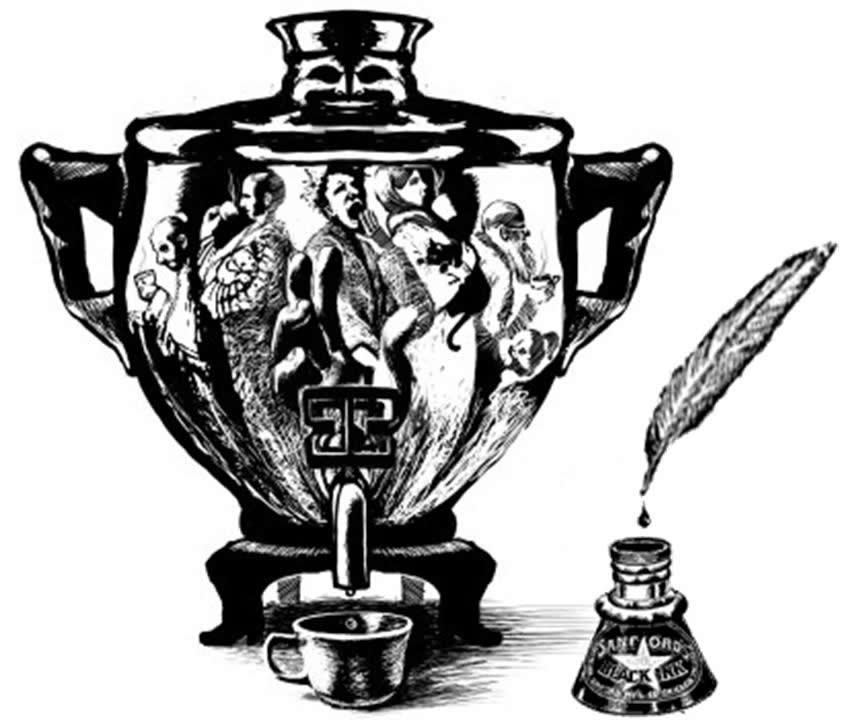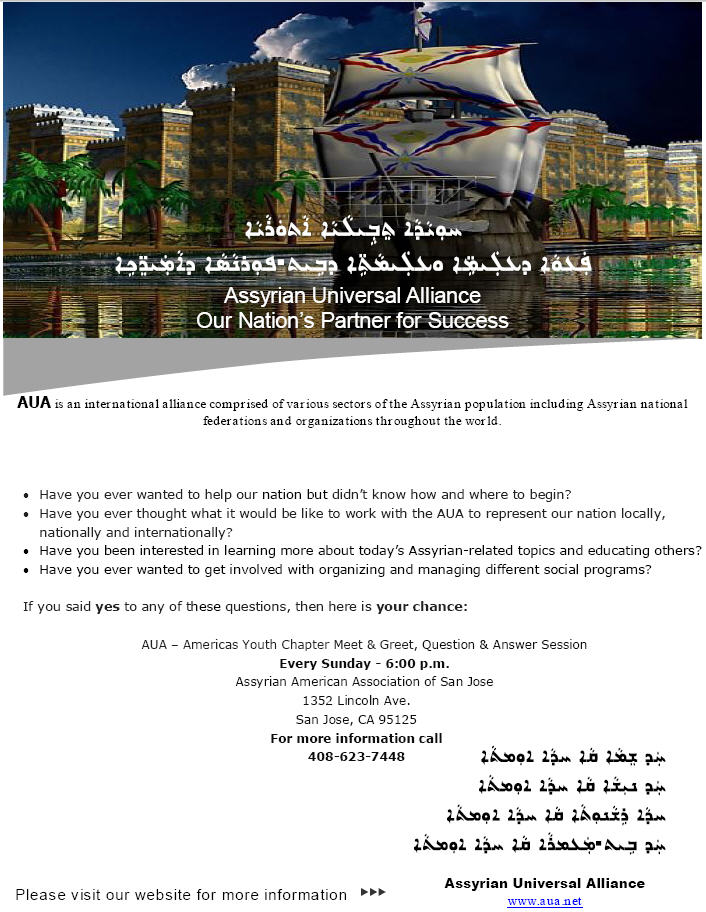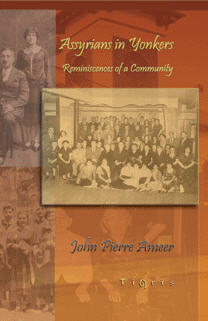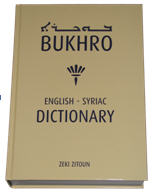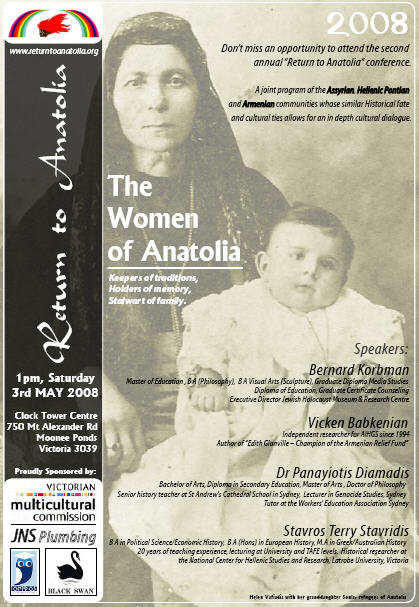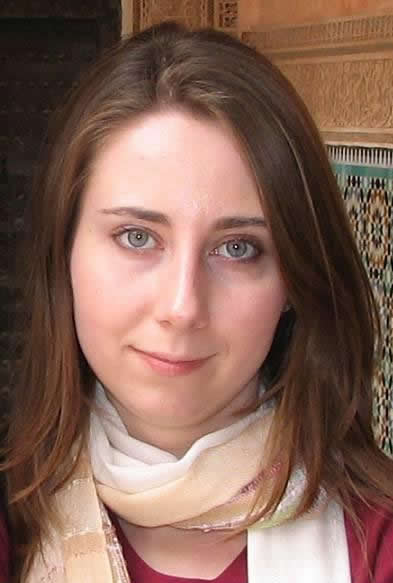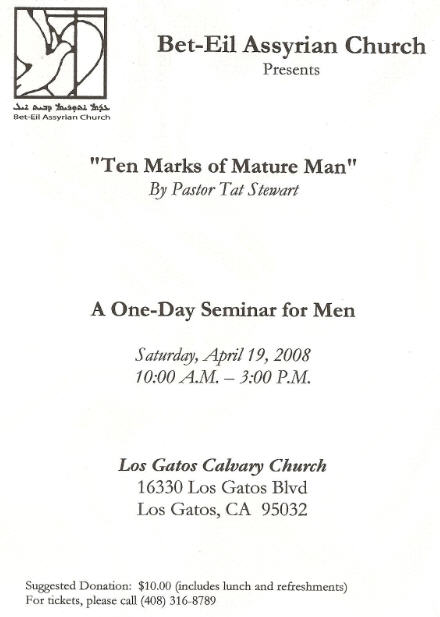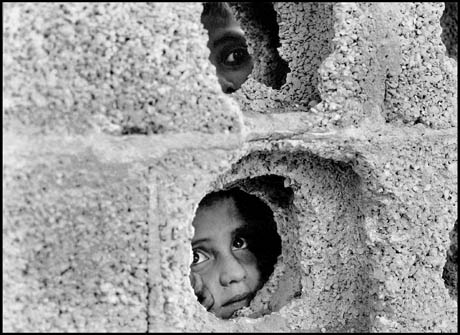Khalil Gibran
Part 2 of 2
To view part 1, click here.
Stan Shabaz
Washington, DC
“How Khalil Gibran amazed America, by preaching The Supreme in the country of the dollar” [1] -- Charles Corm
 |
The Kahlil Gibran Memorial Garden in Washington, D.C. (Photo by Stan Shabaz) |
In part one of this essay, I described Gibran’s family background, his early life, and his connections to the Syriac language. I also reviewed some of his beliefs. As we saw, Gibran was passionate in his commitment to these beliefs and this sometimes earned him an angry reaction from his critics. Let’s now take a look at some of the criticisms and hardships Gibran faced during his lifetime.
His Critics
Gibran’s vehement stands against sectarianism, feudalism, clerical politicking and Ottoman despotism gained him many enemies. Traditionalists and those loyal to the clerical hierarchy were very critical of Gibran:
“Ever since the appearance of The Broken Wings, al-Mashriq, the influential Lebanese literary journal, had attacked his books. In 1912 it labeled his antagonism toward the Church hierarchy as “dirty sayings that belittled the sayer.” By 1923 its tone has not softened. “Who can imagine this poet?” wrote the Jesuit critic Louis Cheikho [2]. “Is he a poet or an idiot? He seems childish, empty like his Great Sea….In his heart is the irreligious microbe.”….In a defense of Cheikho’s criticism al-Mashriq warned that Gibran’s ideas were “lustful and cheap” and his influence pernicious. “Stop reading him!” traditionalists instructed their faithful flocks.” [3]
Likewise the Ottoman’s were also displeased with his works. He received a threatening anonymous letter in 1917 stating: “Turkey is not dead—and she has a long arm—if you do not stop what you are doing.” [4]
He was beset on all sides by the forces of the old guard: Ottoman loyalists, the clerical hierarchy, traditionalists and conservatives, feudal lords and reactionary politicians. Gibran himself commented on all this criticism:
“Critics in the East say many cruel things about me such as I am a destroyer of morals and that I live in the shadow of a strange god. Such criticism does not bother me, however. Indeed, I enjoy it.” [5]
In a letter to his cousin Nakhli, he wrote:
“The apparition of enmity has already appeared. The people in Syria are calling me heretic, and the intelligentsia in Egypt vilifies me, saying, ‘He is the enemy of just laws, of family ties, and of old traditions.’ Those writers are telling the truth, because I do not love man-made laws and I abhor the traditions that our ancestors left us. This hatred is the fruit of my love for the sacred and spiritual kindness which should be the source of every law upon the earth, for kindness is the shadow of God in man. I know that the principles upon which I base my writings are echoes of the spirit of the great majority of the people of the world, because the tendency toward a spiritual independence is to our life as the heart is to the body.” [6]
Likewise, in his essay, “Narcotics and Dissecting Knives”, Gibran replies to his critics:
“ ‘He is excessive and fanatic to the point of madness…Our counsel to the inhabitants of this blessed Mountain (Mount Lebanon) is to reject the insidious teachings of this anarchist and heretic and to burn his books, that his doctrines may not lead the innocent astray. We have read ‘The Broken Wings’ and found it to be honeyed poison.’
Such is what people say of me and they are right, for I am indeed a fanatic and I am inclined toward destruction as well as construction. There is hatred in my heart for that which my detractors sanctify, and love for that which they reject. And if I could uproot certain customs, beliefs and traditions of the people, I would do so without hesitation. When they said my books were poison, they were speaking truth about themselves, for what I say is poison to them. But they falsified when they said I mix honey into it, for I apply the poison full strength and pour it from transparent glass.”[7]
"Madman" and "Heretic"
Given these strong feelings, it was no wonder that Gibran often found himself at odds with the established conservative institutions, families, clergy and politicians of his day. Those who wanted to preserve their inherited power and privileges feared his message of reform and revolution.
Because of this fervent opposition to the antiquated status quo, Gibran much admired those brave souls and mighty minds who challenged societal restrictions and limitations. In this regard, he was fascinated with the concept of madness. Gibran expressed this “personal fascination with the mad”[8] in the following quote:
“In Syria madness is frequent. There has been much contemplative life there for several hundreds of years—and it results in various things: sometimes in extreme nervousness; sometimes in madness; sometimes in just apparent idleness; sometimes in wonderful wisdom.”[9]
What he says here is indeed true. I think it stems from the age of our civilization which stretches back to the dawn of history itself. Throughout these millennia of history our ancestors have devoted themselves to contemplative thought: philosophical, spiritual, ideological and religious. The complexities and subtleties of the millennia flow through our blood and our minds: a complexity of thought, a subtlety of behavior. An intricate complexity and impressive subtlety: occasionally viewed as “madness”, but more accurately viewed as a sign of a distinguished and cultured nation marked by the touch of eternal genius.
This is why Gibran would say that the “people called ‘touched’ are very significant to me.”[10] Likewise, in a letter to Mikhail Naimy in 1921 Gibran writes:
“So you are on the verge of madness. This is a piece of news, magnificent in its fearfulness, fearful in its magnificence and beauty. I say that madness is the first step towards divine sublimation. Be mad, Mischa. Be mad and tell us of the mysteries behind the veil of ‘reason’. Life’s purpose is to bring us nearer to those mysteries; and madness is the surest and the quickest steed. Be mad, and remain a mad brother to your mad brother.”[11]
And in his book, “The Madman” he wrote:
“And I have found both freedom and safety in my madness; the freedom of loneliness and the safety from being understood, for those who understand us enslave something in us.”[12]
Gibran identified with the madman, just as he identified with the heretic. Though he was called a madman and a heretic by his enemies and critics, he never ran away from those labels; quite the opposite, he embraced and reveled in them. He entitled two of his most famous essays “Yuhanna the Madman” and “Khalil the Heretic”. The title characters in both essays were heroic men challenging reactionary and unjust societal mores. Both characters were alter egos of Gibran himself, reflecting his thoughts and beliefs.
Isolation and Loneliness
Gibran often found himself at odds with society and societal strictures binding the minds and souls of men to the whims of narrow-minded rulers and outdated traditions. He often felt like an outsider in his society and was viewed as such by its more conservative elements. This feeling of alienation and opposition was reflected in the titles of several of his works, including: “Spirits Rebellious”, “The Tempest”, “The Madman”, “I am Not Moderate”, “The Lonely Poet”, “Solitude and Isolation”, “Beyond My Solitude”.
Even as a child he was misunderstood by his teachers, peers and especially his father. Yet he always knew that he was different, special:
“All those who knew Gibran as a child said that… he was an eccentric child who loved solitude… sitting alone near the cave of Mar Sarkis (Monastery) drawing.”[13]
And as an adult he embraced this isolation:
“Sometimes I’m almost proud of my hermitage, my loneliness. I’m not accepted—that’s all. I never have been and I never shall be. I just don’t fit.”[14]
Even when working in the national cause to help his people during the famine of World War I he expressed this frustration:
“As for the Syrians, they are even stranger than they used to be. The bosses are getting bossier, and the gossips more gossipy. All these things make me hate life… and if it had not been for the cries of the starving which fill my heart, I would not have stayed in this office for one second… and had I been given the choice of death in Lebanon or life among these creatures I would have chosen death”.[15]
Women and Love
Despite his disappointment and frustration with society and its selfish materialism, he did find solace through his relationships with women. He once said:
“I am indebted for all that I call ‘I’ to women, ever since I was an infant. Women opened the wisdom of my eyes and the doors of my spirit. Had it not been for the woman-mother, the woman-sister, and the woman-friend, I would have been sleeping among those who seek the tranquility of the world with their snoring.”[16]
He also wrote,
“Women’s influence is to be found somewhere behind all the creations of man throughout the centuries. I do not state this as a theory. For me it is a psychological fact, its manifestations being perfectly palpable throughout history.”[17]
This was particularly true for Gibran and the women in his life. First were his beloved mother and his extremely loyal and dutiful sister, Marianne. In terms of romance, we should examine in particular both his first love as well as his last.
His first love was probably his truest and most ideal love. I think this love must have had a profound effect upon Gibran. The woman was known to the world as Selma Karamy, the tragic female character in his novel, “The Broken Wings”. But what is the reality behind the story? As much as we are able to put together it goes like this: While studying at al-Hikma school in Beirut, he fell in love with Hala al-Dahir, a woman “distinguished by beauty and noble birth.”[18] Although, she loved Gibran, her brother, a district official, forbade her to speak to the “son of a goat-tax farmer”. The lovers were forced to meet secretly in a forest near Mar Sarkis monastery. Eventually the reactionary forces of feudalism and patriarchal dominance were brought to bear upon the young lovers. When reading “The Broken Wings” it is easy to see that Gibran truly cared for Hala (“Selma”):
“I was eighteen years of age when love opened my eyes with its magic rays and touched my spirit for the first time with its fiery fingers, and Selma Karamy was the first woman who awakened my spirit with her beauty and led me into the garden of high affection, where days pass like dreams and nights like weddings.
Selma was the one who taught me to worship beauty by the example of her own beauty and revealed to me the secret of love by her affection; she was the one who first sang to me the poetry of real life…..
Oh, friends of my youth who are scattered in the city of Beirut, when you pass by that cemetery near the pine forest, enter it silently and walk slowly so that the tramping of your feet will not disturb the slumber of the dead, and stop humbly by Selma’s tomb and greet the earth that encloses her corpse and mention my name with a deep sigh and say to yourself, ‘Here, all the hopes of Gibran, who is living as a prisoner of love beyond the seas, were buried. On this spot he lost his happiness, drained his tears, and forgot his smile.’ ”
The last love of his life was May Ziadeh, a woman he never was able to meet in person, but with whom he maintained a correspondence throughout many years. May Ziadeh was the daughter of a Lebanese journalist who emigrated to Egypt. She was a highly respected essayist, lecturer, literary critic and feminist. She traveled throughout Europe and knew nine languages. In 1912 she launched a Literary Salon in Cairo, which hosted weekly intellectual debates and literary readings. Participants of her salon included Khalil Mutran, Taha Hussein, Lutfi as-Sayad, Yacoub Sarrouf and Antoun Gemeyal.
Like Gibran she never married. After Gibran’s death, and the death of her parents, she fell into a deep depression. In an attempt to gain control of her estate, her uncle had a doctor state that she was mentally disturbed, which enabled him to have her unjustly hospitalized in a mental asylum. She was forced to endure harsh and inhumane treatment during that confinement and her plight eventually became known to the country at large. Her cause was championed by friends and intellectuals, including Ameen Rihani and Antun Saadeh among others.[19] Eventually they were able to secure her release, but the mistreatment she received in the asylum took its toll. She was able to lecture and write again after her release, but she passed away shortly thereafter in 1941 at the early age of 55; “lonely and friendless except for a handful of faithful admirers.”[20]
The Return Home
Towards the end of his life Gibran felt the intense need to return to his beloved Lebanon. In a letter to May Ziadeh he wrote “My longing for my homeland almost destroys me”;[21] and in a letter to Mikhail Naimy he wrote:
“I say, Mikhail, that the future shall find us in a hermitage on the edge of one of the Lebanon gorges. This deceptive civilization has strained the strings of our spirits to the breaking point. We must depart before they break. But we must remain patient and forebearing until the day of departure.”[22]
Likewise in one of his last letters he said: “I must withdraw myself from this civilization that runs on wheels…I wish to go back to Lebanon and remain there forever.”[23]
He made plans to purchase Mar Sarkis Monastary, but unfortunately, he was too “patient and forebearing”, for death took him, before he was able to make his departure. Yet the final homecoming which eluded him in life was ultimately fulfilled after his death.
Gibran’s friend, journalist Salloum Mokarzel [24] told “The Times” of Gibran’s return to Lebanon:
“At various stages along the road young men, in colorful native costumes, engaged in spirited sword-play before the slowly-moving hearse. Others followed singing martial songs or improvising eulogies for the dead. At a town near Gebail, the ancient Byblos and the seat of worship of the Syrian goddess Astarte, a company of maidens came out to meet the body. They wore loose flowing robes and their long hair fell in heavy waves over their shoulders. They also sang the praise of Gibran, but they did so in the sense of one who is living, welcoming him as ‘the beautiful bridegroom of our dreams’, and scattered roses along the road before him and perfume upon his casket.”[25]
He was laid to rest in the ancient Mar Sarkis monastry in Bsharri. It was a very fitting location, for it was the place where he first started to draw as a child; the place where he secretly met with his first and truest love as a young man; and the place he was making plans to purchase in his last years, in preparation for his long anticipated return to Lebanon. An inscription near his casket reads:
“A word I want to be written on my tomb: I am alive like you and I am standing now at your side, so close your eyes and look around, and you will see me in front of you.”[26]
Gibran’s Legacy
There are many of Gibran’s essays which have become classics: “Dead are My People”, “History and the Nation”,”My Countrymen”, “You have your Lebanon and I Have Mine”, “To Young Americans of Syrian Origin, I Believe in You”, “The Tempest” and several others. These are in addition to his books, such as “The Prophet”, “Jesus: The Son of Man”, and “The Broken Wings”. These works continue to sell around the world to this very day. Gibran’s writings, art and philosophy have had an enormous impact upon the intellectual, cultural and political life of the Near East. There have been songs [27], albums, films [28], books and even national political movements [29] based upon or inspired by his life, his philosophy and his writings. Even some of his quotes have gained of life of their own. Through famous quotes such as:
“Your children are not your children.
They are the sons and daughters of Life's longing for itself.”
…and…
“Are you a politician asking what your country can do for you or a zealous one asking what you can do for your country?” [30]
…and many others, Gibran’s words have become a living and undying legacy: a legacy still influencing and inspiring people to this very day. This legacy is a living and vital heritage bequeathed to us and should be preserved by us and by our future generations so that it will never die.
International Conferences
As an indication of Gibran’s continuing importance there was a conference about him recently held at the University of Maryland. The conference was organized by The Kahlil Gibran Chair for Values and Peace Project, the International Association for the Study of the Life and Works of Kahlil Gibran, the Lebanese-American Heritage Project, the Arab-American Historical Foundation and the University of Maryland. The conference was chaired by Dr. Suheil Bushrui, [31] the distinguished Gibran scholar. In addition to being an authority on Anglo-Irish literature, Dr. Bushrui is also one of the foremost scholars on Gibran in the world. He has dedicated much time and effort in order to preserve, protect and promote Gibran’s intellectual and philosophical legacy.
The conference examined the life and works of Kahlil Gibran, along with his associates Ameen Rihani, Iliya Abu Madi and other early immigrant Arabic language writers and journalists.
“These writers enriched America where they spent the greater part of their lives after arriving as young immigrants from the Middle East. America’s dynamism opened up a world of possibilities to them, and gave rise to the unique East-West synthesis that the English works of Kahlil Gibran, Ameen Rihani, Mikhail Naimy, and others represent. The Arabic works of these three, as well as the other members of the Pen Bond (al-Rabita al-Qalamiyyah)—such as Iliya Abu Madi, Nasib ‘Arida, and ‘Abd-al-Masih Haddad—contributed to the quickening of an Arab literary renaissance in Lebanon and elsewhere in the Arab world.”[32]
Scholars from around the world participated including Irfan Shahid, Miles Brady, Edmund Ghareeb, Michael Suleiman and distinguished Lebanese poet Henri Zoghaib,[33] the director of the Center for Lebanese Heritage, who came from Lebanon to address this conference.
Irfan Shahid and Miles Brady spoke on the life and work of Ameen Rihani. Edmund Ghareeb spoke of his father Andrew Ghareeb, one of Gibran’s translators and an active participant in early Arabic language journalism in America. Also participating were former Arab League Ambassador Clovis Maksoud, ALSAC [34] director Richard Shadyac and Joseph Haiek, publisher of the “News Circle” magazine in southern California. All participants stressed the need to preserve and promote the works and values of Kahlil Gibran.
Along similar lines, the New Pen League recently hosted an evening of music and poetry in Manhattan. “The New Pen League, is a secular, non-political, non-profit organization....It continues the mission of the original Pen League (Arrabitah Al-Qalamyiah), established in New York City…by the poet and writer Khalil Gibran.” [35] The event was held at the penthouse of Dag Hammarskjöld Tower and included readings by Youssef Abdul-Samad, dean of the New Pen League; H.E. Samir Sumaida’ie, Ambassador of Iraq to the United States; Lebanese author and composer Dr. Mansour Ajami; and the prominent Assyrian cardiologist and poet Dr. George Younan, MD. [36] Also in attendance was the noted philosopher and intellectual Sadek al-Azm,[37] who addressed the gathering.
It was indeed an honour to be in the presence of such intellectuals and activists at both events. These events are a testament to Gibran’s continuing and living legacy and its importance for us today and for generations yet to come.
 |
- Corm, Charles, “Sacred Mountain”, pg. 65.
- Louis Cheikho (1859-1927) was born in Mardin; he was of Chaldean ancestry.
- Gibran, Kahlil and Jean Gibran. “Kahlil Gibran: His Life and World” pg. 370.
- Gibran, Kahlil and Jean Gibran. “Kahlil Gibran: His Life and World” pg. 306.
- Huwayyik, Yusuf, “Gibran in Paris”, pg. 35.
- Kahlil Gibran: A Self-Portrait, “Letter to Nakhli Gibran, March 15, 1908” pg. 28.
- Gibran, Kahlil, “Thoughts and Meditation”, pg. 91-92.
- Gibran, Kahlil and Jean Gibran. “Kahlil Gibran: His Life and World” pg. 259.
- Gibran, Kahlil and Jean Gibran. “Kahlil Gibran: His Life and World” pg. 260.
- Bushrui, Suheil, “Kahlil Gibran Man and Poet”, pg. 168.
- Naimy, Mikhail, “Kahlil Gibran: His Life and Works”, pg. 252.
- Kahlil Gibran, “The Madman”, pg. 8.
- Hawi, Khalil. “Kahlil Gibran: His Background, Character and Works”, pg. 84.
- Waterfield, Robin, “Prophet: The Life and Times of Kahlil Gibran”, pg. 171 (Emphasis added.)
- Hawi, Khalil. “Kahlil Gibran: His Background, Character and Works”, pg. 106.
- Gibran, Kahlil. “Kahlil Gibran: A Self-Portrait”, Letter to May Ziadeh, 1928”, pg. 84.
- Gibran, Khalil and Jean Gibran. “Khalil Gibran: His Life and World” pg. 277.
- Hawi, Khalil. “Kahlil Gibran: His Background, Character and Works”, pg. 88.
- Regarding May Ziadeh, Antun Saadeh wrote that “Only very few male writers in Syria and Lebanon come close to the high cultural level, the feelings and the art of May’s writings.”
- Bushrui, Suheil and Salma Haffar al-Kuzbari, “Gibran: Love Letters”, pg. xiv.
- Bushrui, Suheil and Salma Haffar al-Kuzbari, “Gibran: Love Letters”, pg. 12
- Naimy, Mikhail.“Kahlil Gibran: His Life and Works”, pg. 255.
- Gibran, Kahlil. “Kahlil Gibran: A Self-Portrait”, Letter to Felix Farris, 1930”, pg. 94. (Emphasis added.)
- Salloum Mokarzel (1881-1952) was publisher of the classic journal “The Syrian World” from 1926 to 1932. “The Syrian World” was a monthly English language journal which included contributions from Kahlil Gibran, Philip Hitti, Mikhail Naimy, Ameen Rihani and many others.
- Waterfield, Robin, “Prophet: The Life and Times of Kahlil Gibran”, pg. 280.
- Waterfield, Robin, “Prophet: The Life and Times of Kahlil Gibran”, pg. 281-282
- The thoughts, beliefs and quotes of Gibran have found their way into several musical works including lyrics in songs of Fairouz (see A’tini al-Nay, al-Ardou Lakom, Ya Bani Oummi, etc) and the Beatles (see the song Julia in the Beatles White album) among others.
- The 1964 film “al Ajniha al Moutakassira” (“The Broken Wings”) by Youssef Maalouf, starring the great Lebanese actress Nidal al-Achkar. See “Le Cinema Libanais” by Hady Zaccak, pg. 73-75.
- See “Kahlil Gibran: His Background, Character and Works” by Khalil Hawi, pg. 154-155. Also see “Gibran and the National Idea” by Adel Beshara, in “Middle East Quarterly”, Autumn 1994. pg. 30-33 and Jan Dayah “Aqida Jubran”, 1988. Of course, Gibran’s thought was so overwhelming it had a pervasive impact on numerous political, ideological, cultural and literary trends and reformist movements.
- Used in President Kennedy’s famous inaugural address.
- From 1982 to 1988, Professor Bushrui was Cultural Advisor and official interpreter to the President of the Republic of Lebanon. In 1983 he headed a presidential committee in Lebanon which organized the international celebrations to commemorate the 100th anniversary of the birth of Kahlil Gibran. These activities focused on the theme of Unity in Diversity and were held in Beirut, Oxford, London, and Washington, D.C. Professor Bushrui's published work is extensive, in both English and Arabic; his work on Gibran, in particular, has been translated into French, Italian, Spanish and Chinese. His most recent publications include: the first annotated edition of Gibran's “The Prophet” (1995); “The Ethical Dimensions of Science, Art, Religion, and Politics” (1996, co-edited with Miles Bradbury); as well as an up-to-date biography of Gibran entitled “Kahlil Gibran: Man and Poet”.
- From the conference agenda.
- Henri Zoghaib also founded the poetry magazine “L’Odyssee” in 1982 and the Odyssee Cultural Committee in 1996. The committee organizes cultural, literary and artistic festivals.
- The American Lebanese Syrian Associated Charities (ALSAC) is a charitable fund raising organization which raises funds for St. Jude Children’s research hospital. ALSAC is the third largest healthcare related charity in the United States. St. Jude Children’s Hospital was founded by the great Lebanese entertainer Amos Jacobs (Danny Thomas).
- From the program brochure.
- K. George Younan, MD is a board certified cardiologist and internist who has served as Bayshore Community Hospital’s chief of medicine and as chairperson of critical care. Dr. Younan has also served as a past president of the prestigious National Arab American Medical Association (NAAMA) and as editor-in-chief of NAAMA’s “al-Hakim” magazine.
- Sadek Jalal al-Azm works include “al-Naqd al-Thati Ba’d al-Hazima” (A Self-Critique in the Wake of Defeat), about the 1967 war; “Naqd al-Fikr al-Dini” (A Critique of Religious Thought); “Thihniyat al-Tahrim” (The Taboo Mentality); and “Ma Ba’da Thihniyat al-Tahrim” (Beyond the Taboo Mentality).
Drama of Iraqi Refugee Women and Children in Syria
Markus Urek
For Tukish Daily News
1 April 2008
New York
On March 20, 2003, Iraq was invaded by American and British troops which ended the dictatorship of Saddam Hussein. The citizens of Baghdad celebrated the fall of Saddam with enthusiasm, without knowing that for most of them internal displacement would become their sole option of survival. After a while it has been understood that U.S. troops and the so-called democratic Iraqi government were unable to control the violence between the Islamist extremist groups and other ethnic groups.
Dreaming of democracy was unusual for Iraqis as they have more serious problems to think about. The UNHCR in 2007 reported that around 5 million people had fled their country out of which approximately 1.5 million Iraqi refugees established new lives in Syria.
The big exodus
After 400,000 displaced Palestinian refugees, Syria with its small economy and its multi-ethnical and religious background became the only hope of survival to almost 1.5 million Iraqis. These people are Shiite, Sunni, Druze, Turkmen and Christians. The Kurds didn't leave. Sunnis settled to the high rent areas such as Mazeh, the Assyrians Christian preferred middle class Christian areas like Jarmana and Doelha, and The Shiites settled around Set Zaynab Damascus.
Most of the refugees were women and children with different backgrounds and mixed socio-economic classes. Almost half of those people have a university or have postgraduate degree according to a survey done by IPSOS.
Ninos Bar Karmo, who lived three years in Jaramana Syria, explains their dramatic arrival at the settlement: “People where happy to escape from violence but they were also sad for leaving their homes without seeing a future.” They migrated to Syria in huge numbers. The Syrians were very surprised by so many refugees. Trucks, buses and cars carried thousands and thousands of people to no future.
A resident of Syria confirmed that some of the refugees were rich but not all of them. Later he added; “There were some families who couldn't afford any rent too.” Some rich Sunnis started businesses especially; Assyrian Christians depended on their families or relatives in USA and Europe.” Also, a priest from Damascus said; “The Kurdish government of north Iraq, tries to help Christians who are in financial trouble in the suburbs of Damascus.”
The fact that some of the refugees were rich doesn't cover the truth of severe economical crisis between some refugee families. Bar Karmo states that there are a lot of Iraqi children and widow women on the streets of Damascus whose husbands were kidnapped or killed because of the conflict of Iraq. After living five years in Syria most of them became already teenagers and even some of them were born in Syria. The life has been very tough for widows and children. Not all of them were lucky to get jobs.
Prostitution to survive
As Bar Karmo adds; “I am not sure but I heard that prostitute business was common among Shiite refugees, especially among widows and families who have young daughters without any male in their families.” Although it is very dramatic he continues; “the Syrian prostitutes complained about the big competition that intensified after the Iraqi refugee came to Syria. Hence, making love with a prostitute became affordable for many Syrians.”
Also, according to Forbes most Iraqi refugee families were forced to prostitute their daughters in order to be able to survive. Moreover, the so called pleasure marriages are increasing in Syria leading to more sexual exploitation of the Iraqi refugee daughters.
The child labor among Iraqi refugees is very high, too. According to World Press Reports Iraqi children are forced into child labor. Around 10 percent are pushed into the work force for an income of $1 a day and around 80 percent cannot attend school. Even some families live with the salaries of child labor.
Iraqi refugees' especially women and children deserve better life standards. Those kids who are raised in refugee camps will be the youth and parents of tomorrow. In order to prevent their camps of becoming a cradle for hatred and violence, they need to be raised in better conditions. Moreover, widows with children need special attention in order to prevent their kids from being traumatized and exploited.
As Syria has political problems with United States the world is not aware of the humanitarian drama going on in Syria. Also the Syrian government is not ready to let international NGOs to operate within its territories. According to the bulletin of Refugee International, the money provided by UNHCR is not sufficient, the agency asking for $261 million in 2008 in order to be able to provide protection and shelter to the Iraqi refugees.
It looks like fights between Iraqi ethnic and religious groups will continue. This means that the Iraqi refugees will have to stay longer in Syria and the women and children will pay by their body. Their future in Syria is shadowed and foggy. After a while, the Syrians and the Syrian government will not be able to handle the humanitarian crisis. It may be true that the Iraqi refugee women chose non-heterodox ways to survive, but no one can argue that they do that for pleasure.
Crusaders and others
Almost everyone in Middle East believes that U.S. is the cause of the bloody conflict in Iraq. It might be true or not. Here, the following questions should be addressed: If Americans are the reason of the bloody struggle, why do Iraqi people with the same ethnic and religious background kill each other? If the Americans are the crusaders why doesn't the Arab League help the displaced Iraqi refugees everywhere? The mother country of Islam is Saudi Arabia and Saudi Arabia closed the doors to Iraqi refugees. As a result, if the West or the Americans are the crusaders, why the Iraqis or other Islamic leaders don't take any action to prevent the ethnic and sects conflict?
 Markus Urek is an Assyrian from Turkey and a Fulbright Scholar studying at the New School in New York. Markus Urek is an Assyrian from Turkey and a Fulbright Scholar studying at the New School in New York.
Why Assyrians Should be Inspired by Malta
Emil Brikha
Malta
Those who know me know that I left Sweden to move to Malta just a couple of days ago, leaving darkness, cold weather and cold people behind. What none of you probably know though is the history of Malta and reading this won’t make you any wiser in that aspect.
There is just one thing that my mind can’t grasp. I am, not surprisingly Assyrian, dwelling in the ruins of greatness, picking my feet clean from fragments and splinters of my people’s history as I walk barefoot through life. I come from a great people with a magnificent heritage of mind boggling ingenuity, intelligence and forward thinking.
Where are we in 2008? Scattered, shattered, bickering, bitching and fighting over politics, dialects, flags and religion. We are all over the world (I have not yet found a single Assyrian in Malta though) and there are millions of us. Many of us forgetting or not learning our own language and history. Many of us not bounding, not understanding and not being given the chance or opportunity to form and uphold any sense of actually being Assyrian. This is what we are in 2008.
Now look at Malta. This tiny 25 km or so long island with its 400 000 inhabitants have been in bed with many countries but never became anyone’s bitch. In 2008 it is a country with its own language which is a beautiful love child formed through various “bed partners” into what is today the Maltese language. They have their flag and they raise it proudly. They are a member of the European Union, just converted to the euro and are well on their way to reach new heights in development both economical and infrastructural (you can thank the nationalist party for that).
So what is our problem? Granted, Malta has never been a threat to any nation and most would argue this is why Malta has been left alone. Okay, Assyrians were and are still heavily targeted because of their religion in a Muslim dominated area of the world but still. We are again, millions of people, most of us schooled and educated or at the very least not retarded but we are still following the same patterns, repeating the same mistakes, reducing ourselves to even smaller beings as far as Assyrianism goes.
Some Assyrians fight loudly, aggressively and passionately for their cause. Some have done it all their life, grown up in a family with active parents within the movement through various organisation and in that way had their Assyrian identity parallel with whatever life they lived in whichever country they were living. Then there are others, like me, who grew up outside of the Assyrian movement, with parents who themselves were raised without any greater insight or knowledge about the history which lead to these living generations of Assyrians. I didn’t wake up until one of these loud and passionate Assyrians introduced herself to me and engaged in discussions with me. Discussions which did not only change how I view my people but also how I view myself and my own identity, which made me loud and passionate about my cause, or our cause rather.
It is this awakening that is needed across all continents and tiny islands where Assyrians live but it requires that we are open to the change within. Untill then we won’t see any real change and Assyrians will still be divided, still bickering and still bitching and arguing over nonsens. Still to busy impressing friends, neighbours and family with superficial things instead of rebuilding, teaching, understanding and loving. I salute Malta and all active Assyrians this evening with my hand on my heart wishing Assyrians all over the world one day can come together as one.
 Zinda recently discovered Mr. Brikha and his writing from the island of Malta. He's a writer, music producer, performer and photographer, and has a website where he posts his articles. To read more of Mr. Brikha's insights and to converse with him (he may indeed be the only Assyrian in Malta) please visit his blog here. Zinda recently discovered Mr. Brikha and his writing from the island of Malta. He's a writer, music producer, performer and photographer, and has a website where he posts his articles. To read more of Mr. Brikha's insights and to converse with him (he may indeed be the only Assyrian in Malta) please visit his blog here.
Assyrian Attire ... Civilization, Grace and Beauty
Mary Challita
Canada
Studying Assyrian artistic scenes as they are discovered during excavations; reflect a very important aspect of the Assyrians’ civilization and their grace, specially the murals which depict their fashions as well as ornamental elements adorning these outstanding sculptures.
Dr. Shahla abd el-Razzaq Bashir, a literature professor at Mosul’s university says: The first thing noticed by a researcher into Assyrian attire, is that they were highly adorned, colorful and were intended as being festive and ritual, in particular the royal attire which was adorned with jewelry, golden ornaments and embroidered with colorful threads. The historical information shows that most of the attire was made of silk in addition to wool, linen and leather which were also used to adorn some clothes with golden and bronze embroidery. It’s known that King Sennacherib brought cotton as well as its trees and planted them, the tree then was known to the Assyrians as “the tree which gives wool”.
The Assyrians used legendary winged symbols, the sacred tree branches which were depicted in several styles and different forms of animals; these were embroidered on royal coats, in the middle of the piece and royal crowns using Lotus and Camomile flowers. It’s worthy noting that the Assyrians preserved without change a unity of themes and special ornamental methods throughout their rule, these adorning methods spread to neighboring peoples such as the Phoenicians, this shows the authenticity, grace and beauty of Assyrian attire.
Dr. Shahla adds that studying costumes and their methods, provide researchers with pointers and ideas about every day life then along with the actual work which was done on the sculptures and murals, in addition to details about the social life at the royal court including attire for religious ceremonies, clothes used for hunting, war and what the Kings wore when they were ill to chase away evil spirits.
It should be also mentioned that the influence of Assyrian fashions continued during later times and this influence can be also seen in Islamic arts and at present times, for if we reflect on the nature of clothes and fashions in the northern parts of Iraq, we can clearly see that the population of that area tend to prefer adorned clothes with deep and bight colors.
Colors used in Assyrian fashions and as the cuneiform texts show played a prominent role in explaining some of the common concepts at the time, specially the red, white and other colors derived from red which were extracted from plant, animal and mineral sources. For the Assyrians, the red color had several meanings including chasing away evil spirits while the white color symbolized purity, cleanliness and was worn by the King and his high priests during religious festivals.
The Assyrians’ inclination towards the deep, strong colors in their fashions presented a necessary harmony and the power of these colors when exposed to the sun showed the body’s lines and features.
Historians, Assyriologists, and Noted Writers have not been Kind to the Assyrians
Anthony T. Nasseri
California
In a modern age our historical interests, like all form of our behavior are subject to changes. Little over a century and half ago, the perception of contemporary historians, scholars and noted writers about the complexity of Assyrian history was entirely overhauled, but not about Assyrians, the people. It is the people that makes the history. The historical knowledge of western scholars, historians and writers was limited to what Jewish human prophets had professed about the historical events that took place between the Assyrian Empire, Judea and Israel. Those write-ups were compiled in the form of historical events in the Bible. Not withstanding the fact; who was created first. The Egg or the Hen.
For many centuries, western people believed their civilization was a gift inherited from the Roman Empire, followed by the Greece. While the Greek philosophers repeatedly wrote, that they have been benefited from an earlier civilization without an open reference to the ancient Empires of Mesopotamia.
When Napoleon Bonaparte came to the country of Egypt in 1799. He was confronted with pyramids, temple-cities, half buried in the desert sand. Guarded by the stone beasts called Sphinxes. His French scholars advised him, the existence of an ancient civilization. Through archeological efforts that followed, revealed to the western people, that a high civilization had existed in Egypt, long before he Roman and the Greek civilization. Was the origin of our civilization only in Egypt?
As logical as that conclusion would have seemed, the facts militated against it. But the ancient source of knowledge and wisdom of which they spoke was based elsewhere. Scholars knew of the Greek contacts with near-east. Culminating with the defeat of the Persian Empire by Alexander of Macedonia in 331 BC, and his extended stay until his death in Babylon.
Mesopotamia became part of Hellenistic world, during the Seleucid period of rule. Seleucids, a Hellenic dynasty founded by Seleucus-I, ruled over Asia minor from 312-to 64 BC. Mesopotamia once again was invaded. This time by kingdom of Parthians, the people from the north-east of Iran. Who reached the height of its influence at the beginning of the fist century BC. Followed by wars of domination by the Roman Empire and the Persians, extending beyond the early Christianity. The Assyrians maintained their political identity through the rule by the Abgars dynasty from 609 BC, through 300 AD. Although, weak in power, but strong in culture.
Writing the history of ancient Assyria to conform with expectation of historian and historical science is one thing. Translation, pronunciation and editing the available records, which are to undergo the scrutiny only by critical historians leaving the remnants of their heritage aside is another. Although, the modern man does not believe the Assyrian still exist. The ancient Assyrians when preparing and recording their historical events did not imagined or foresee the demands to be made upon them by contemporary non-Assyrian Historian.
When Austin Henry Layard began his excavation at the sight of Nineveh in 1845, an Assyrian Hormuzd Rassam a remnant Assyrian from his ancestors, who was fluenin Aramaic, Arabic and English. Assembled the best crew of workmen for the project. Commenced his initial duty in capacity of the paymaster. He became immensely useful to the initial archaeology project. Did it hurt the English archaeologist to employ an Assyrian by extracting the artifacts of his forefathers civilization? In fact Mr. Rassam through his initial contribution to the success of the first archaeological project, earned the admiration of his employer.
When Sir. Austin H. Layard observed Rassam dedication, loyalty and honest hard work. He rewarded him to enroll at university of Oxford to further his education. Mr. Rassam with added knowledge and experience, became an established archaeologist and a well informed Assyriologist. He was officially employed by the British Museum in several of its undertakings in northern, Iraq and elsewhere in Mesopotamia.
Although, I am not a proficient scholar nor a highly educated historian. Yet I feel the genius of my forefathers, with inheritance of their natural wisdom. Along with adequate historical knowledge through study and research of my ancestors civilization. Which compels me to recall the evolution of my thoughts, in order to advocate against mischievous representation by those semitics nations who replaced us. The present semitic people namely, some of the Persian, the Jews and the Arabs, also the Hellenics not only they have made a mockery of our history. Copied whatever they deemed it necessary, such as names, language, literature and historical events, to upgrade their own history. Also they have set a precedent to change our historical names of places, and of rulers to suit their purpose.
The Assyrian language differs in many respect from the other semitic people, because from the beginning, it has been a base language. The Assyrian dialect is subdivided into old Assyrian dialect (2000-1500)BC, middle Assyrian dialect (1500-1000) BC and neo Assyrian dialect (1000-600) BC. From eight century BC, Aramaic a semitic language penetrated the Assyrian society through Arameans, a nomadic tribe from Syrian desert became widespread as a spoken language. Gradually replacing the Akkadian writings scribes of cuneiform. The Aramaic was depicted in sculptured reliefs, continued working side by side with old language at that time. The Akkadian cuneiform writing was discontinued by 140 BC.
The alphabet of this Aramaic language was independent, but the analogy of the numbers of characters and their sounds was based on the Phoenician version. It is simple to write with pen and ink on paper or material. The old Aramaic dialect was in use from 975-to-700 BC. Standard dialect was in use from 700-to-200 BC which became an international language of the area. Middle dialect was in use from 200 BC to 200 AD. Our Lord Jesus Christ spoke this language. Later dialect reverted back to the standard dialect of 700 BC with an influence for adoption some words from Persian, Turkish and European languages.
The remnant of those Assyrians are very much alive today, in Iraq, Syria, Lebanon, Iran, Israel, Turkey, Europe, Australia and the United States of America, we continue to read, write, and speak the Aramaic language and maintain our ancestors traditions. Although, we have become the wanderers of history, yet our struggle for survival and for achieving political recognition does continue.
The parallels
To begin with, let us review similarities, of important events in the life of the ancient man. Deciphered on the clay tablets by the ancient Empires of Mesopotamia, in contrast to that recorded by the Jewish in the Bible, and ancient historical publication by Persian and the Arabs.
A- The Creation
The seven tablets of creation from the famous library of Ashurbanipal Emperor of Nineveh, Assyria, presently stored at the British Museum in London, England. In the beginning the whole universe was a sea. Heaven at high had not been named, nor the earth beneath. The first who had being were the god Lachmu and goddess Lachamu. Then were created the god Anshar and goddess Kishar. Anu god of the sky, his consort Anatu. Ea god of the deep, Enki Lord of the earth, etc. Babylonian doctrine set forth that mankind was created not only to worship the gods. Also to bring about the redemption of the fallen gods who followed Tiamat. ( Just a briefed version.)
A-l The creation in Genesis
In the beginning God created the heavens and the earth. The earth was without form and void, and darkness was upon the face of the deep; ad the spirit of the God was moving over the face of the water. The God said, let us make a man in our image. So God created man in his own image, in the image of God he created him; male and female he created them.
B- The legend of Deluge
The gods assembled in the city of Shurippak the city by the banks of Euphrates. The council voted on the destruction of mankind by means of deluge. The vote and the decision were kept secret. But Enki searched out Ut-napishtim the ruler of the city to warn him of the approaching calamity. He also advised him to build a ship with dimensions 120 cubits wide and 120 cubits in height. To be smeared with bitumen inside and pitch outside, and to be ready I seven days. The launching was difficult, but after two-third of the structure had gone into the water of Euphrates. Ut-napishtim put all his family and kin aboard the ship, including all the craftsmen who had helped in building the ship. Whatever I had of all the living creatures, as well as the animal and wild beasts of the field.
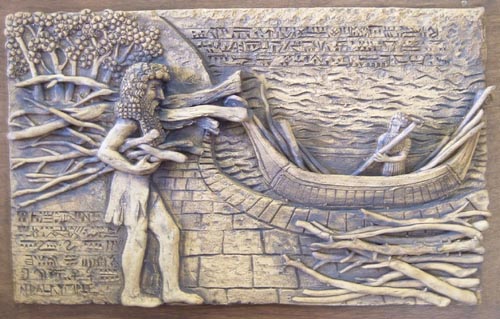 |
| The story of the Deluge (Flood) as told by the Mesopotamian writers preceeds that of the Biblical authorship. From Mesopotamia this story was spead to Palestine where it was incorporated into the Biblical book of Genesis. The hero of the story in Mesopotamia was known as Utnapishti. In Genesis he is referred to as Noah. |
The storm came with the first glow of dawn. There was an awesome thunder. A black cloud rose up from the horizon. Darkness followed, turning to blackness all that had been light; and the wide land was shattered like pot. For six days and six nights the south-storm gathering the speed as it blew. Submerging the land, mountains. Overtaking the people like a battle. When the seventh day arrived, the flood carrying south-storm subsided in the battle which had fought like an army. The sea grew quiet, the tempest was still, the flood ceased. Looking at weather stillness had set in, and all mankind had returned to clay. The will of Enlil and the assembly of gods was done.
Unknown to the gods, the scheme of Enki had also worked. Floating in the stormy waters was a vessel carrying men, women, children and other living creatures. With storm over, Ut-napishtim opened the hatch, light fell upon my face. He looked around the landscape was as level as a flat roof. Bowing low, he sat and wept, tears running on his face. Then there emerged a mountain region, on the mount of salvation the ship came to a halt. For six days Ut-napishtim watched from the motionless ark, caught in the peak of the mount of salvation. He sent out a dove to look for a resting place, but it came back. A swallow flew out and came back. Then a raven was set free and flew off, finding a resting place. Ut-napishtim then released all the birds and animals that were with him, and stepped out himself.
He built an alter and offered a sacrifice. The Gods smelled the sweet savor, crowded like flies around the alter. When Enlil finally arrived on the scene, he was hopping mad to discover that some humans had survived. Enki mixed denial with confession. It was not I who disclosed the secret of the gods. I merely let the man perceive by his own wisdom the gods decision, and let us not ignore his abilities. Enlil thereupon holding Ut-napishtim hand and took him and his wife aboard the ship. He stood between them, made his wife to kneel beside me, he touched our forehead to bless us. Henceforth Ut-napishtim and his wife shall be unto us like gods, and shall reside in the far away at the mouth of the waters.
B-l The story of flood in Genesis: 6-5 through – 8-11
The Lord saw that the wickedness of man was great in the earth, and that every imagination of the thoughts of his heart was only evil continually. And the Lord was sorry that he had made man on earth, and it grieved him to his heart. So the Lord said, I will blot out man whom I have created from the face of the ground, man and beast and creeping things and birds of the air, for I am sorry that I have made them. And God saw the earth, was filled with violence. For all the flesh had corrupted their way upon the earth.
And God said to Noah, I have determined to make an end of all flesh. Behold I will destroy them with the earth. Make yourself an ark of gopher wood; make room in the ark, and cover it inside and out with pitch. The length of the ark three hundred cubits, its breadth fifty cubits, and its height thirty cubits. For behold I will bring a flood of waters upon the earth, to destroy all flesh in which is the breath of life from under heaven.
But I will establish my covenant with you; and you shall come to the ark, you, your sons, your wife, and your sons wives with you. You shall bring two of every sort of birds and animals, male and female. Also take with you every sort of food that is eaten. All the fountains of the great deep burst forth, and the windows of the haven were opened. And rain fell upon the earth forty days forty nights. And the waters increased, and bore up the ark, and it rose high above the earth. The ark floated on the face of the waters. And the waters prevailed so mightily upon the earth that all the high mountains under the whole heaven were covered; and all flesh died that moved upon the earth.
At the end of forty days Noah opened the window of the ark which he had made, and sent forth a raven. Then he sent forth a dove, but the dove found no place and returned to the ark. He waited another seven days, and sent forth the dove out of the ark, and the dove came back to him in the evening and lo, in her mouth a freshly plucked olive leaf; so Noah knew that waters had subsided from the earth.
C- Sargon of Akkad: A mighty king of antiquity narrate his birth of 2,370 BC
My father was an alien, my mother was a vestal ( a virgin priestess). When my mother conceived me, launched me on the river of Euphrates, in a pitch covered basket. The river floated me to Akki. The water drawer. Akki educated me as his son. I was beloved by the goddess Ishtar, who assisted me to become a mighty king of Akkad.
C-1 Moses of the Bible: Exodus 2-1 through 2-10
Now a man from the house of Levi went and took to wife a daughter of Levi. The woman conceived and bore a son; and when she saw a goodly child, she hid him three months. And when she could hide him no longer she took for him a basket made of bulrushes, daubed it with bitumen and pitch; And she put the child in it and placed it among the reeds at the river’s brink. The daughter of Pharaoh came down to bathe at the river, she saw the basket among the reeds and send her maid to fetch it. The child grew and became the son of Pharaoh’s daughter. He named him Moses.
The Jewish tradition of divine wrath upon the Assyrian and Babylonians
Manifestation of anger - l
In 701 BC Sennacherib (Sankhiro-in-Assyrian) The Assyrian King marched against the king of Judah. A strong Assyrian force overrun Palestine, defeated the Egyptian troops at Eltekeh, took the rebel cities with exception of Jerusalem and rewarded loyal vassals in the Philistine cities with the grant of territories formerly belonging to Judah. Because of the new development in Babylonia necessitated the early return of Assyrian forces to the homeland, Sennacherib did not press the siege of Jesusalem, and Hezekiah’s city was spared by his submission and payment of Gold, silver, jewels, costly furniture, musicians and female slaves.
Wrath – 1 ( 2 Kings: 19-35-36)
And that night the angel of the Lord slew a hundred and eighty five thousand in the camp of the Assyrians; and when men arose early in the morning behold, these were all dead bodies. Then Sennacherib king of Assyria departed, and went home, and dwelt at Nineveh. Note: No such an incident has been recorded in the Assyrian History. Explanation: The camp of King Sennacherib army was visited in the night by swarms of the field mice which ate up the quivers, bows and the leather handles of shields.
Manifestation of anger – 2
In 597 BC Nebuchadrezzar II (Nebuchad-Nasir in Assyrian) sent force to besiege Jerusalem. (Ur.Shalim in Assyria=city of peace) Jehoiakim king of Judah had the good fortune to die during the siege, his son Jehoiachin, was taken captive to Babylon, together with nobility, craftsmen and troops.
In 589-570 BC The Egyptian forces invaded Palestine, took sidon and Jerusalem, Babylonia garrison was forced to retire. Nebuchadrezzar king of Babylon reacted strongly. The Egyptian made a hurried withdrawal. Leaving their vassals to be dealt with piecemeal by the Babylonian forces. Jerusalem was blockaded for eighteen months, finally starved out. 586 BC Zedekia the last king of Judah was blinded and taken captive to Babylon. Anti-Babylonian leaders were put to death. Jerusalem looted, and a large section of population deported to Babylonia to undertake the agricultural work.
Wrath -2 Daniel 4: 28-33
All this came upon king Nebuchadnezzar. At the end of twelve months he was walking on the roof of royal palace of Babylon, and the king said, is not this great Babylon, which I have built by my mighty power as a royal residence and for the glory of my majesty? While the words were still in the king’s mouth, there fell a voice from heaven, “O king Nebuchadnezzar, to you it is spoken: The kingdom has departed from you, and you shall be driven from among men, and you dwelling shall be with the beasts of the field; and you shall be made to eat grass like an ox; and seven times shall pass over you, until you have learned that the most high rules the kingdom of the men and gives it to whom he will. Immediately the word was fulfilled upon Nebuchadnezzar. He was driven from among men, and ate grass like an ox, and his body was wet with the dew of heaven till his hair grew as long as eagle’s feathers, and his nail were like bird’s claw.
Note: No such an incident has been recorded in the Assyrian and Babylonia history.
Explanation: Ten years of withdrawal of Nabu-na’id the king of Assyria and Babylon from his capital because of skin disease. H.W.F. Saggs a noted historian in his book The Greatness That Was Babylon page 149 writes. Quote: Another form of what is clearly the same Jewish tradition of divine wrath upon a new Babylonia king though in this case linked specifically with Nabu-na’id instead Nebuchadrezzer has appeared amongst the documents from Qumran the so-called Dead Sea Scrolls. Unquote.
The Languages
The Arabs, the Jews and the Greeks their alphabet characters have been derived from Assyrian Aramaic alphabet. They have twenty two characters, with same sound; particularly the Hebrew alphabet is a copy of same. Over forty percent of the Arab and Hebrew languages have a mixture of Aramaic language.
Names
The land occupied by four major empires of antiquity; namely Sumer, Babylon, Akkad and Assyria is known as the land between two rivers. Only the Assyrian called their homeland: The land between two rivers. (Bit-Nahrin) The Greeks followed us with name of Mesopotamia, with exactly same meaning. Why is it all the scholars, noted writers, Assyriologists, are using foreign name when elaborating on our ancient civilization. For example: Sumer is incorrect. The Arab and Persian called it Sumer. The Jewish Call it Shinar. The Correct name “Shumer.”-Shumerian.
The analogy of the foregoing events does require proper consideration and clarification, by the noted contemporary scholars, historians, and writers. I assume for some particular reasons the answers contained in the Ashurbanipal library are being kept stagnant in the British museum of London,England.
Gulf a Haven for Christian Communities
Courtesy of the Gulf Times
15 March 2008
By Fran Gillespie
TODAY, when the first Catholic church in Qatar is consecrated by Cardinal Ivan Dias at Mesaimeer, a remarkable milestone in the history of Qatar will be reached. Although this is the first Catholic church in Qatar, it is not the first church.
Centuries ago, long before the Revelation of Islam in the 7th century AD, Christian communities flourished along the shores of the Arabian Gulf and southwards along the Indian Ocean. They were followers of the Nestorian doctrine, named after a Syrian monk, Nestorius, who died in 451 AD.
Christianity spread from its earliest home in Palestine and found homes among both Jewish and Hellenistic populations in both settled and nomadic territories. A 2nd century writer, Justin the Martyr, speaks of the spread of the faith among ‘tented herdsmen’. The first Christian king, Abgar, ruled from 177 -212 in what is now Iraq. The earliest church building yet found, at Dura on the Euphrates river, dates to the 3rd century. There is evidence of Christian monasteries located along the overland trade routes in the region and acting as caravanserai.
The historical recreation of the spread of Christianity in the Arabian Gulf is difficult and is complicated by the disappearance of many written records during the numerous early conflicts in the region. But what is known from Byzantine and Syrian ecclesiastical records is that there were five sees [bishoprics] on the western side of the Gulf by the early 5th century.
Qatar was one of the five, and the area included the whole peninsula. Along with Bahrain and the eastern seaboard of Saudi Arabia, it was known by the Syrian name of Beth Qatraye. The diocesan bishop in Qatar from c.650 onwards until at least 676 was Thomas. In that year a Council was held in Qatar to deal with some disciplinary issues which had been troubling the Gulf churches and the names of several bishops who attended the Council are recorded, including that of Bishop Thomas.
The see of Bahrain included the mainland, probably stretching from north of the present Jubail southwards through the Al Hasa oasis and including Qatif. Hatta is known to have had churches and bishops.
The other sees were Darin, now known as Tarut Island and situated just off the coast of Saudi Arabia, Mashmahiq, which is the modern island of Muharraq, site of Bahrain Airport, and ‘Uman. The see of ‘Uman, which included Oman and the area included in the present-day United Arab Emirates, was based at Suhar and the province had links with India and East Africa.
One of the greatest of the pre-Islamic poets, Labid, was born in the mid-6th century. In later life he converted to Islam and was honoured by having some of his work chosen as mu’allaqat: written in gold letters and hung inside the holy Ka’aba. In early life Labid wrote a fascinating account of his travels down the east coast of Arabia and describes, as he approached settlements, the beating of clappers [naqus] of the churches calling the inhabitants to worship.
To date, no structures dating to the Christian era have yet been discovered in either Bahrain or Qatar, although it seems almost certain, from the records of bishops and councils that such structures must have existed, even if they were no more than barasti [palm leaf] huts. New and comprehensive archaeological surveys are currently taking place in Qatar, and it may well be that eventually the remains of ecclesiastical buildings will be found here.
Until a little over 20 years ago nothing was known about church buildings in the region. Then, in February 1986, a young Saudi national was driving his newly acquired 4x4 vehicle across some dunes near Jubail when he became stuck. As he was digging it out he came across the top of a wall which disappeared down into the sand.
Unfortunately, instead of contacting the Department of Antiquities the young man first informed the police. They brought in a local contractor who dug out the sand around the buried structure, doing considerable damage in the process. When a wall with distinctive crosses came to light the Department of Antiquities was immediately notified, and archaeologists then excavated the rest of the building and put a protective fence around it. The remains of other buildings could be seen beneath the sands, indicating that it was part of a small settlement.
The church complex consisted of a courtyard and three rooms on its east side. There were the remains of plaster decorated with crosses. The range of potsherds indicated that the church may have been in use from the 5th to the 9th centuries.
The finding of the church came as a considerable surprise, and because of its proximity to the coast Saudi archaeologists at first described it as a seafarers’ chapel. But Muslim archival statements about Islam’s tolerance of “the peoples of the book”, provided they paid their taxes, the site evidence and, later, the discovery of a second church not far away at Thaj suggests it is more likely to have been a parish or monastic structure situated within a stable community. Grave slabs with crosses crudely incised on them were found a few hundred metres away from the Jubail church.
The following year a church dating to the 5th to 6th centuries was found and excavated by French archaeologists on Failaka island off Kuwait. Again, plaster fragments were found, bearing traces of Nestorian-style crosses with flared arms, and other sacred art. There were several rooms around the central church, which had a nave and side aisles. Tombs were embedded in the walls of the side chapels.
In 1992 the Abu Dhabi Islands Archaeological Survey began excavations on the island of Sir Bani Yas and over the course of several seasons uncovered a group of stone built and plastered houses, a large administrative building and a Christian monastic complex. The church was built on a low mound and had a nave, apse and two aisles, plus an adjacent complex of around 13 small rooms with enclosed courtyards.
The church was decorated with finely-made plaster motifs, with designs including typical Nestorian crosses, palm trees and grape vines bearing bunches of grapes. Most of them were on the inside of the building although there also appears to have been a frieze running around the outside of the eastern doorway. In 1996 a burial was found just outside the doorway, suggesting that this was a person of importance, perhaps a bishop or even the founder of the community.
The plaster had survived when the walls toppled over after the building was abandoned. There is no evidence of destruction; it was simply left to fall into ruin. All the evidence points to what is confirmed by Nestorian church records, that following the Revelation of Islam in 627 -629 the majority of the people of the Arabian Gulf, whether Christian or pagan, peacefully converted to Islam, the new faith being adopted by leaders like the Christian governor of Hasa Oasis in the eastern province of Saudi Arabia. Those Christians who chose to retain their beliefs were tolerated and continued to fill official posts.
The fact that the monastery on Sir Bani Yas survived into the Ummayid period, as is proved by the remains of datable pottery, showed that the occupants practised their religion freely during the early decades of the Islamic era.
The opening of the Catholic church of Our Lady of the Rosary today at Mesaimeer is, therefore, a symbol not only of historic importance but also of the freedom of worship which is guaranteed by the government of Qatar, just as it was in the earliest days of Islam. |
|
Book Review: Paul Batou's "My Last Thoughts About Iraq"
Camille-Yvette Weslch
Forward Magazine
Batou’s book is one of longing, for a lost civilization, a dispersed people, an ancient beauty still moldering under the remains of Baghdad. These poems might easily be characterized as extended lament. Batou approaches them from multiple perspectives, from lost son to gypsy guitar player, but in all of the poems, loss figures prominently as it has for thousands of years in the region.
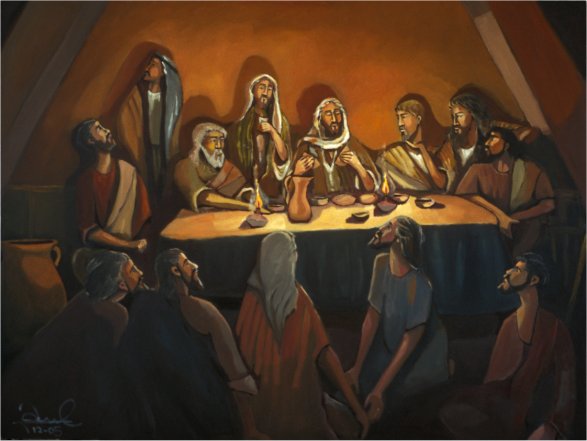 |
A recent painting titled "The Last Supper" by the Assyrian artist, Paul Batou. |
Batou approaches his subject in many ways, through music, painting, and words. He carefully introduces the circumstances from which modern Iraq has evolved, then offers reproductions of his paintings so that readers might experience the turmoil in a new way. The book then makes its way into poems which take place both in Iraq and in the United States where Batou has made his life. Unfortunately, the United States is never fully home to Batou; like other immigrants before him, he never finds himself fully integrated into American culture.
Many of the poems in this volume cover the same territory, laments to God over what has been lost, ruminations on the glory that was, prayers for what might be. He writes of isolation in “Journey with Ishtar”: “We live as strangers in different lands. / We live as drunks with no alcohol.” Batou likens himself to the gypsies, forever wandering, forever singing his lament. He mourns in “Iraqi Freedom,” “My sadness is written on rocks and clay, / Placed in museums around the planet. / My stories and sadness were stolen by strangers and thieves.” Batou tries to explain the devastation wrought by the Iraqi war. He urges his readers to remember with him the songs of folk singers, the ease of the elderly resting in the shade, the joy of a new bride.
While initially the poems have persuasive, mournful power, the edge is dulled by repetition. Rather than delving into new ways to figure the city and her history, Batou sticks to a few central images and ideas: tiny villages, simple suffering people, spiritual lands. In creating images, the poet might further explore the power of figurative language. With a history as rich as Mesopotamia’s, Batou has innumerable options for language, allusion, and image, but he fails to mine it as fully as he might. He lingers too long reestablishing loss in every poem. He would do well to trust the progression inherent in a volume, and build on the history and long literary tradition of this place he so loves.
 Camille-Yvette Welsch is an instructor of English and the Advising Coordinator for Undergraduate Studies in English and American Studies at the Pennsylvania State University. Her work has appeared in Barrow Street, Mid-American Review, The Women's Review of Books, Calyx and Red Cedar Review, among others. Camille-Yvette Welsch is an instructor of English and the Advising Coordinator for Undergraduate Studies in English and American Studies at the Pennsylvania State University. Her work has appeared in Barrow Street, Mid-American Review, The Women's Review of Books, Calyx and Red Cedar Review, among others.
It is the Death of History
Courtesy of the Independent (London)
Special investigation by Robert Fisk
First Published on 17 September 2007
2,000-year-old Sumerian cities torn apart and plundered by robbers. The very walls of the mighty Ur of the Chaldees cracking under the strain of massive troop movements, the privatisation of looting as landlords buy up the remaining sites of ancient Mesopotamia to strip them of their artefacts and wealth. The near total destruction of Iraq's historic past – the very cradle of human civilisation – has emerged as one of the most shameful symbols of our disastrous occupation.
Evidence amassed by archaeologists shows that even those Iraqis who trained as archaeological workers in Saddam Hussein's regime are now using their knowledge to join the looters in digging through the ancient cities, destroying thousands of priceless jars, bottles and other artefacts in their search for gold and other treasures.
In the aftermath of the 1991 Gulf War, armies of looters moved in on the desert cities of southern Iraq and at least 13 Iraqi museums were plundered. Today, almost every archaeological site in southern Iraq is under the control of looters.
In a long and devastating appraisal to be published in December, Lebanese archaeologist Joanne Farchakh says that armies of looters have not spared "one metre of these Sumerian capitals that have been buried under the sand for thousands of years.
"They systematically destroyed the remains of this civilisation in their tireless search for sellable artefacts: ancient cities, covering an estimated surface area of 20 square kilometres, which – if properly excavated – could have provided extensive new information concerning the development of the human race.
"Humankind is losing its past for a cuneiform tablet or a sculpture or piece of jewellery that the dealer buys and pays for in cash in a country devastated by war. Humankind is losing its history for the pleasure of private collectors living safely in their luxurious houses and ordering specific objects for their collection."
Ms Farchakh, who helped with the original investigation into stolen treasures from the Baghdad Archaeological Museum in the immediate aftermath of the invasion of Iraq, says Iraq may soon end up with no history.
"There are 10,000 archaeological sites in the country. In the Nassariyah area alone, there are about 840 Sumerian sites; they have all been systematically looted. Even when Alexander the Great destroyed a city, he would always build another. But now the robbers are destroying everything because they are going down to bedrock. What's new is that the looters are becoming more and more organised with, apparently, lots of money.
"Quite apart from this, military operations are damaging these sites forever. There's been a US base in Ur for five years and the walls are cracking because of the weight of military vehicles. It's like putting an archaeological site under a continuous earthquake."
Of all the ancient cities of present-day Iraq, Ur is regarded as the most important in the history of man-kind. Mentioned in the Old Testament – and believed by many to be the home of the Prophet Abraham – it also features in the works of Arab historians and geographers where its name is Qamirnah, The City of the Moon.
Founded in about 4,000 BC, its Sumerian people established the principles of irrigation, developed agriculture and metal-working. Fifteen hundred years later – in what has become known as "the age of the deluge" – Ur produced some of the first examples of writing, seal inscriptions and construction. In neighbouring Larsa, baked clay bricks were used as money orders – the world's first cheques – the depth of finger indentations in the clay marking the amount of money to be transferred. The royal tombs of Ur contained jewellery, daggers, gold, azurite cylindrical seals and sometimes the remains of slaves.
US officers have repeatedly said a large American base built at Babylon was to protect the site but Iraqi archaeologist Zainab Bah-rani, a professor of art history and archaeology at Columbia University, says this "beggars belief". In an analysis of the city, she says: "The damage done to Babylon is both extensive and irreparable, and even if US forces had wanted to protect it, placing guards round the site would have been far more sensible than bulldozing it and setting up the largest coalition military headquarters in the region."
Air strikes in 2003 left historical monuments undamaged, but Professor Bahrani, says: "The occupation has resulted in a tremendous destruction of history well beyond the museums and libraries looted and destroyed at the fall of Baghdad. At least seven historical sites have been used in this way by US and coalition forces since April 2003, one of them being the historical heart of Samarra, where the Askari shrine built by Nasr al Din Shah was bombed in 2006."
The use of heritage sites as military bases is a breach of the Hague Convention and Protocol of 1954 (chapter 1, article 5) which covers periods of occupation; although the US did not ratify the Convention, Italy, Poland, Australia and Holland, all of whom sent forces to Iraq, are contracting parties.
Ms Farchakh notes that as religious parties gain influence in all the Iraqi pro-vinces, archaeological sites are also falling under their control. She tells of Abdulamir Hamdani, the director of antiquities for Di Qar province in the south who desperately – but vainly – tried to prevent the destruction of the buried cities during the occupation. Dr Hamdani himself wrote that he can do little to prevent "the disaster we are all witnessing and observing".
In 2006, he says: "We recruited 200 police officers because we were trying to stop the looting by patrolling the sites as often as possible. Our equipment was not enough for this mission because we only had eight cars, some guns and other weapons and a few radio transmitters for the entire province where 800 archaeological sites have been inventoried.
"Of course, this is not enough but we were trying to establish some order until money restrictions within the government meant that we could no longer pay for the fuel to patrol the sites. So we ended up in our offices trying to fight the looting, but that was also before the religious parties took over southern Iraq."
Last year, Dr Hamdani's antiquities department received notice from the local authorities, approving the creation of mud-brick factories in areas surrounding Sumerian archaeological sites. But it quickly became apparent that the factory owners intended to buy the land from the Iraqi government because it covered several Sumerian capitals and other archaeological sites. The new landlord would "dig" the archaeological site, dissolve the "old mud brick" to form the new one for the market and sell the unearthed finds to antiquity traders.
Dr Hamdani bravely refused to sign the dossier. Ms Farchakh says: "His rejection had rapid consequences. The religious parties controlling Nassariyah sent the police to see him with orders to jail him on corruption charges. He was imprisoned for three months, awaiting trial. The State Board of Antiquities and Heritage defended him during his trial, as did his powerful tribe. He was released and regained his position. The mud-brick factories are 'frozen projects', but reports have surfaced of a similar strategy being employed in other cities and in nearby archaeological sites such as the Aqarakouf Ziggarat near Baghdad. For how long can Iraqi archaeologists maintain order? This is a question only Iraqi politicians affiliated to the different religious parties can answer, since they approve these projects."
Police efforts to break the power of the looters, now with a well-organised support structure helped by tribal leaders, have proved lethal. In 2005, the Iraqi customs arrested – with the help of Western troops – several antiquities dealers in the town of Al Fajr, near Nasseriyah. They seized hundreds of artefacts and decided to take them to the museum in Baghdad. It was a fatal mistake.
The convoy was stopped a few miles from Baghdad, eight of the customs agents were murdered, and their bodies burnt and left to rot in the desert. The artefacts disappeared. "It was a clear message from the antiquities dealers to the world," Ms Farchakh says.
The legions of antiquities looters work within a smooth mass-smuggling organisation. Trucks, cars, planes and boats take Iraq's historical plunder to Europe, the US, to the United Arab Emirates and to Japan. The archaeologists say an ever-growing number of internet websites offer Mesopotamian artefacts, objects anywhere up to 7,000 years old.
The farmers of southern Iraq are now professional looters, knowing how to outline the walls of buried buildings and able to break directly into rooms and tombs. The archaeologists' report says: "They have been trained in how to rob the world of its past and they have been making significant profit from it. They know the value of each object and it is difficult to see why they would stop looting."
After the 1991 Gulf War, archaeologists hired the previous looters as workers and promised them government salaries. This system worked as long as the archaeologists remained on the sites, but it was one of the main reasons for the later destruction; people now knew how to excavate and what they could find.
Ms Farchakh adds: "The longer Iraq finds itself in a state of war, the more the cradle of civilisation is threatened. It may not even last for our grandchildren to learn from."
ZINDA ENDORSES MICHAEL YOUNAN FOR THE 9TH CONGRESSIONAL DISTRICT
 Click above banner to learn more.
Click above banner to learn more. |
|


